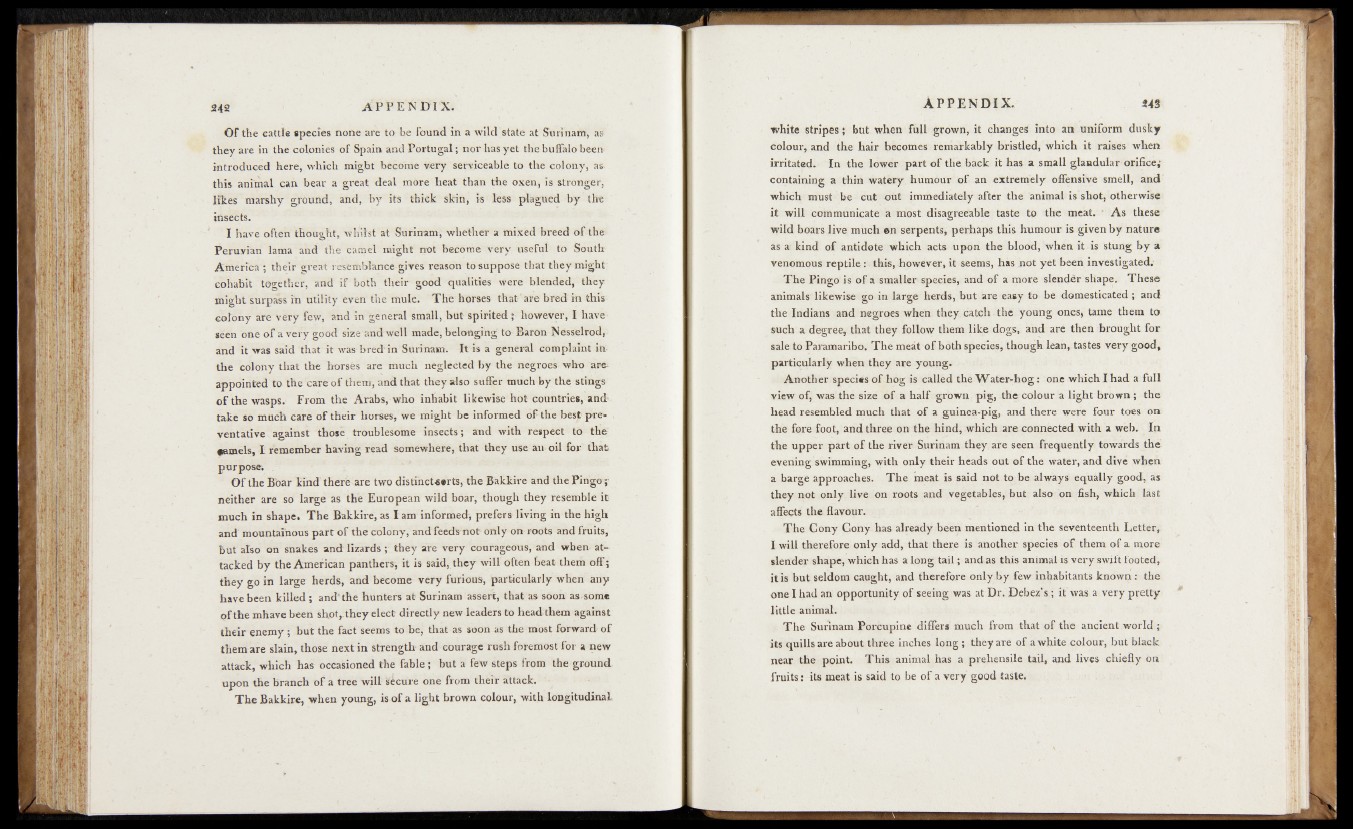
Of the cattle species none are to fee found in a wild state at Surinam, as
they are in the colonies of Spain and Portugal; nor has yet the buffalo been-
introduced here, which might become very serviceable to the colony, as-
this animal can bear a great deal m6re heat than the oxen, is stronger,
likes marshy ground, and, by its thick skin, is less plagued by the
insects.
I have often thought, whilst at Surinam, whether a mixed breed of the
Peruvian lama and the camel might not become very useful to South
America ; their great resemblance gives reason to suppose that they might;
cohabit together, and if both their good qualities Were blended, they
might surpass m utility even the mule. The horses that-' are bred in this
colony are very few, and in ’general small, but spirited; however, I have
seen one o f a very good size and well made, belonging to Baron Nesselrod,
and it was said that it was bred' in Surinam. It is a general complaint ia-
the colony that the horses are much neglected by the negroes who arc
appointed to the care o f them, and that they also suffer much by the stings
o f the wasps. From the Arabs, who inhabit likewise hot countries, and
take so much care of their horses, we might be informed of the besjt preventative.
against those troublesome insects ; and with respect to the
tamels, t remember having read somewhere, that they use an oil for that
purpose*
Of theBbar kind thereare two distmcUerts, the Bakkire and the Pingo;
neither are so large as the European wild boar, though they resemble it-
much in shape» The Bakkire, a s l am informed, prefers living in the high
and' mountainous part o f the colony, and feedsmot only on roots and fruits,
but also on snakes and lizards; they are very courageous, and when- attacked
by the American panthers; it is said,, they will often beat them off;
they go in large herds, and become very furious, particularly when any
have been killed ; and the hunters at- Surinam assert* that as soon as-some
of the mhave been shot,: they elect directly new leaders to head them against
their enemy ; but the fact seems to be, that as soon as the most forward of
them are slain, those next in strength and courage rush foremost for a new
attack, which has occasioned the fable; but a few steps from the ground
upon the branch o f a tree will V^cure one from their attack. -
The Bakkire, when young, is of a light brown colour, with longitudinal
white stripes; but when full grown, it changes into an uniform dusky
colour, and the hair becomes remarkably bristled, which it raises when
irritated. Tn the lower part of the back it has a small glandular orifice^
containing a thin watery, humour o f an extremely offensive smell, and
which must be cut oüt immediately after the animal is shot, otherwise
it will communicate'k:most disagreeable taste to the meat. t As these1
wild boars live much en serpents, perhaps this humour is given by nature
as a‘ kind of antidote which acts upon the blood, when it-is stung by a
venomous r ep tile th is , however, it seems, has .hot yet been investigated;
The Pingo is o f a smaller species, and pf a more siendèr shape. These
animals likewise go in large herds, but are easy id: be domesticated; and
the Indians and negroes when, they catch the young ones* tame them to
such a degree, that they follow them like dogs, and are then brought for
sale to Paramaribo. The meat of both species, though lean, tastes very good,
particularly when they are young.
Another species of hog is called the ater-hog; one which I had a full
view of, was the size o f a half grown pig, the colour ?a light brown ; the
head resembled much that of a guinea-pig, and there were four toes on
the fore foot, and three on the hind, which are connected with a web. In
the upper part of the river Surinam they, are seen frequently towards the
evening swimming, with only their heads out of the Water, and diyé when
a barge approaches. The ineat is said not tnfee always- equally good, as
they not only live on roots and vegetables, but also on fish, which last
affects the flavour.
The Cony Cony has already been mentioned in the seventeenth Letter,.
I will therefore only add, that there is another species o f them of a more
slender shape, which has a long: tail; and as this animal is veyy swift footed,
it is but seldom caught, and therefore only.by few inhabitants known: the
one I had an opportunity of seeing was at Dr. Debez’s.; it was a very pretty
little animal.
The Surinam Porcupine differs much from that o f thé ancient world;
its quills are about three inches long; they are of a white colour, but black
near the point. This animal has a prehensile tail, and lives chiefly on
fruits : its meat is said to be of a very good taste.